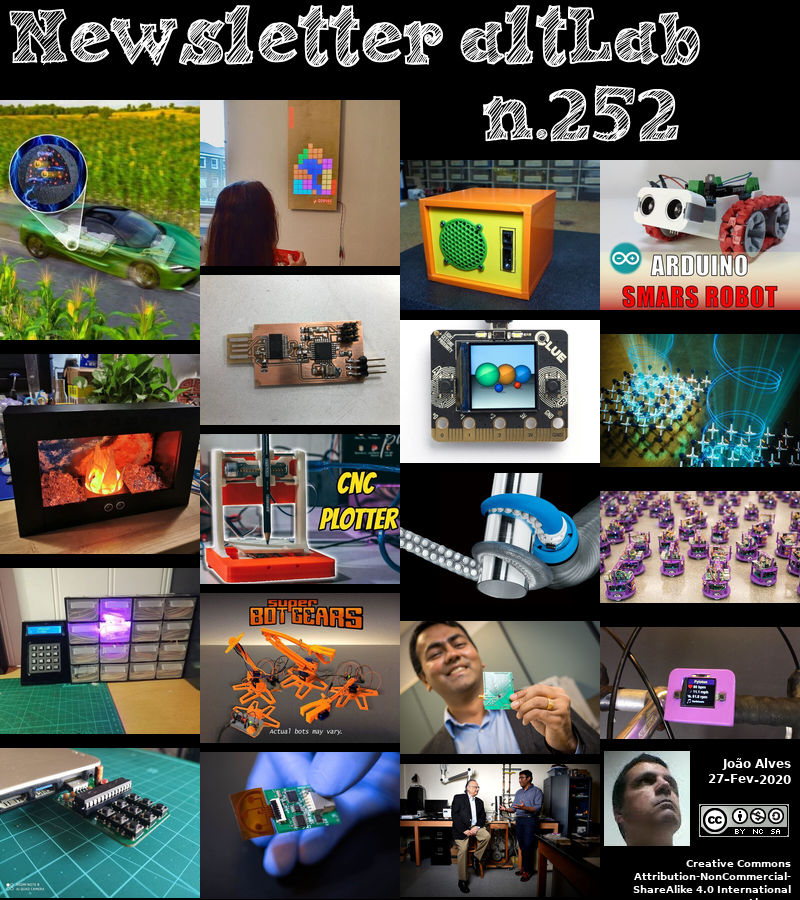2020-02-27 - Nº 252
Editorial
Esta é a Newsletter Nº 252 que se apresenta com o mesmo formato que as anteriores. Se gostar da Newsletter partilhe-a!
Todas as Newsletters encontram-se indexadas no link.
Esta Newsletter tem os seguintes tópicos:
Faz hoje anos que nascia, em 1891, o inventor norte-americano David Sarnoff. Ele foi pioneiro no desenvolvimento de transmissões de rádio e televisão. Ele foi o primeiro responsável da RCA e fundou a rede de televisão NBC (1926). Ele tornou-se um operador de radio e conheceu Marconi em 1906. Prevendo as múltiplas possibilidades do rádio, tornou-se gerente comercial da American Marconi em 1917, já a prever que o rádio se tornaria "um utilitário doméstico no mesmo sentido que o piano ou o fonógrafo".
Faz também hoje anos que nascia, em 1910, o engenheiro aeronáutico norte-americano Kelly Johnson. Ele enquanto geria a divisão secreta de projectos da Lockheed, conhecida como "Skunk Works", contribuiu para o desenvolvimento de mais de 40 aviões. Os seus primeiros trabalhos incluíram o caça P-38 Lightning (1938) e o bombardeiro Hudson. Mais tarde, ele desenvolveu os aviões supersónicos e de maior voo do mundo. O U-2 (1954) foi o primeiro avião projectado para voos de rotina acima de 60.000 pés. O F-104 Starfighter (1954) era capaz de voar ao dobro da velocidade do som, estabelecendo recordes mundiais de 1.400 mph e 103.000 pés de altitude.
Por fim, faz hoje anos que nascia, em 1947, o Físico teórico e cosmologista norte-americano Alan Guth. Ele é pioneiro na apresentação do modelo de expansão do universo. Este modelo explica o crescimento exponencial do universo em meras fracções de segundo após o Big Bang e sua expansão contínua hoje.
Nesta semana que passou ficámos a saber que o Raspberry PI comemora o seu oitavo aniversário. E nesta comemoração, ajudada pela redução dos custos de produção foi anunciado que o Raspberry PI 4 B de 2 GB de memória irá ficar ao preço do de 1GB, ou seja sensivelmente 35€. Também esta semana ficámos a saber que o nosso planeta tem uma 2ª Lua! Bom, parece que de acordo com observações dos astrónomos Kacper Wierzchos e Theodore Pruyne este objecto tem entre 1,8 e 3,8 metros de diâmetro. Foi designada de 2020 CD3 e dá a volta ao planeta a cada 47 dias, tendo ficado preso na força gravitacional da Terra à cerca de três anos. No entanto este asteróide está apenas de visita e assim que se conseguir libertar da força de atracção da Terra seguirá o seu caminho, estimando-se que seja já em Abril deste ano.
Na Newsletter desta semana apresentamos diversos projetos de maker. É apresentada a revista MagPI Nº91 do mês de Março assim como a revista newelectronics de 25 de Fevereiro e o livro "Code the Classics – Volume 1".
 João Alves ([email protected])
João Alves ([email protected])
O conteúdo da Newsletter encontra-se sob a licença  Creative Commons Attribution-NonCommercial-ShareAlike 4.0 International License.
Creative Commons Attribution-NonCommercial-ShareAlike 4.0 International License.
Novidades da Semana
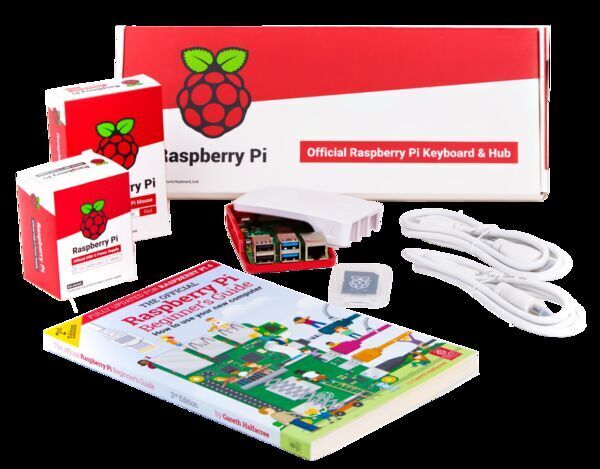
A birthday gift: 2GB Raspberry Pi 4 now only $35
"TL;DR: it’s our eighth birthday, and falling RAM prices have allowed us to cut the price of the 2GB Raspberry Pi 4 to $35. You can buy one here. Happy birthday to us In two days’ time, it will be our eighth birthday (or our second, depending on your point of view). Many of you set your alarms and got up early on the morning of 29 February 2012, to order your Raspberry Pi from our newly minted licensee partners, RS Components and Premier Farnell. In the years since, we’ve sold over 30 million Raspberry Pi computers; we’ve seen our products used in an incredible range of applications all over the world (and occasionally off it); and we’ve found our own place in a community of makers, hobbyists, engineers and educators who are changing the world, one project, or one student, at a time. The first Raspberry Pi When we first started talking about Raspberry Pi 1 Model B back in 2011, we were very clear about what we were trying to build: a desktop Linux PC with interfacing capabilities for $35." [...]

Earth has a new mini-moon, but don’t get too attached
"For the last two and a half years, the Earth may have had two moons. There’s the obvious one that raises the tides and can often be seen during the day, and now researchers have identified a candidate for a second. The “mini-moon,” as some are calling it, is a couch-sized speck roughly 10 trillion times dimmer than its more famous counterpart. And astronomers found the satellite just in time, because soon it will be gone forever. Kacper Wierzchos and Theodore Pruyne, astronomers with the NASA-funded Catalina Sky Survey, first spotted the object. They estimate it measures between six and 12 feet long, and it streaked across the sky on February 15 while they scanned for asteroids." [...]
Outras Notícias
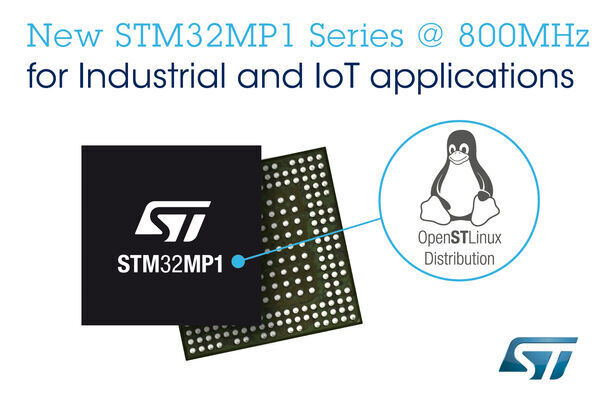
STMicroelectronics Boosts Performance While Enhancing Ecosystem on STM32 Microprocessors
"STMicroelectronics (NYSE:STM), a global semiconductor leader serving customers across the spectrum of electronics applications, is expanding its STM32MP1 microprocessor (MPU) offering with the addition of new authorized partners, new software functionalities, and a significant performance bump by increasing the clock speed to 800MHz, maintaining software and pin-to-pin compatibility with the 650MHz devices. The new STM32MP1 MPUs, now running dual Arm® Cortex®-A7 application processor cores at 800MHz and the Cortex-M4 core at 209MHz, deliver more performance in Voice and Audio Processing, up to HD Video Decoding quality, more powerful AI (Artificial Intelligence) capabilities in Neural-Network and Machine-Learning applications, and better user experience in Android systems. The devices feature compute and 3D graphics accelerators combined with power-efficient real-time control and high feature integration. “The popular HMI toolkit Qt and its QML-based GUI applications can be deployed on STM32 MCUs as well as on the STM32MP1 platform, thereby drastically reducing development costs while accelerating customer product delivery,” said Petteri Holländer, SVP, The Qt Company. “The scalability provided by both ST & Qt tools suite can easily leverage the resources of the STM32MP1, especially the 3D HW GPU accelerator to optimize a smooth rendering for HMI Industrial / IoT applications.” Capitalizing on the flexible STM32MP1 architecture, the security has been enhanced to protect the customer’s code through features like secure boot by authentication, available One-Time Programmable fuses for customers, and a secure operating system (OP-TEE: Trusted Execution Environment). A complete security toolset including Keys Generator, Signing Tools, STM32CubeProgrammer, and Hardware Security Module (STM32HSM) allows secure provisioning of the customers’ secrets into the device." [...]
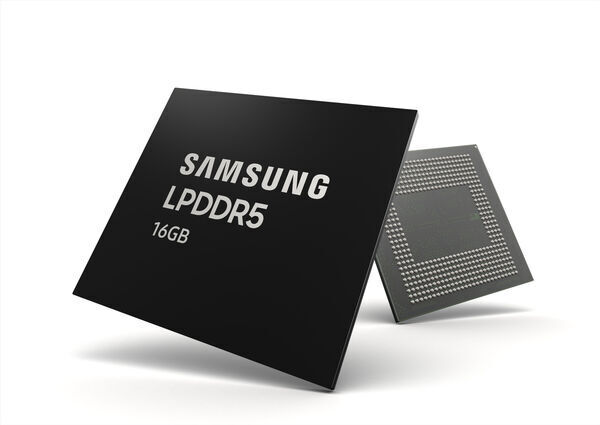
Samsung Begins Mass Production of Industry’s First 16GB LPDDR5 DRAM for Next-Generation Premium Smartphones
"Based on Samsung’s 2nd-generation 10nm-class process technology, the 16GB LPDDR5 mobile DRAM package delivers industry’s highest performance and largest capacity Samsung Electronics, a world leader in advanced memory technology, today announced that it has begun mass producing the industry’s first 16-gigabyte (GB) LPDDR5 mobile DRAM package for next-generation premium smartphones. Following mass production of the industry-first 12GB LPDDR5 in July, 2019, the new 16GB advancement will lead the premium mobile memory market with added capacity that enables enhanced 5G and AI features including graphic-rich gaming and smart photography. “Samsung has been committed to bringing memory technologies to the cutting edge in allowing consumers to enjoy amazing experiences through their mobile devices. We are excited to stay true to that commitment with our new, top-of-the-line mobile solution for global device manufacturers,” said Cheol Choi, senior vice president of memory sales & marketing, Samsung Electronics. “With the introduction of a new product lineup based on our next-generation process technology later this year, Samsung will be able to fully address future memory demands from global customers.” Data transfer rate for the 16GB LPDDR5 comes in at 5,500 megabits per second (Mb/s), approximately 1.3 times faster than the previous mobile memory (LPDDR4X, 4266Mb/s). Compared to an 8GB LPDDR4X package, the new mobile DRAM delivers more than 20-percent energy savings while providing up to twice the capacity." [...]
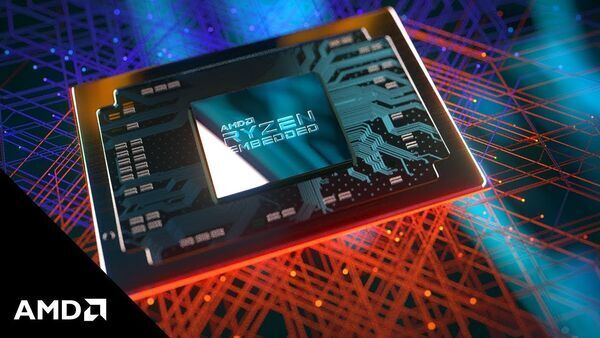
New AMD Processors Drive High-Performance Computing for Embedded Industry
"AMD (NASDAQ: AMD) today announced the expansion of the AMD Ryzen™ Embedded ecosystem with two new AMD Ryzen™ Embedded R1000 low-power processors that provide customers with a new TDP range of 6 up to 10 watts. AMD also announced new customers offering Mini PCs based on the AMD Ryzen Embedded processors from Sapphire, SECO, Simply NUC and others. “AMD is ushering in a new age of high-performance computing for the embedded industry,” said Rajneesh Gaur, corporate vice president and general manager, Embedded Solutions, AMD. “We are doing this with cutting-edge technology to display immersive graphics in 4K resolution with AMD Ryzen Embedded processors, and we are now offering access to high performance in power-efficient solutions with these new low-power Ryzen Embedded R1000 processors.” New AMD Ryzen Embedded Processors In April 2019, AMD launched an expansion to the Ryzen Embedded processor lineup with the AMD Ryzen Embedded R1000 SoC. Built on “Zen” CPU and Radeon™ “Vega” graphics cores, the Ryzen Embedded R1000 processor delivers 3X better CPU performance per watt compared to the previous generation AMD R-series Embedded processor, and 4X better CPU and graphics performance per dollar than the competition2. The AMD Ryzen Embedded R1000 family now includes two new processors designed for efficient power envelopes, the Ryzen™ Embedded R1102G and R1305G processors." [...]
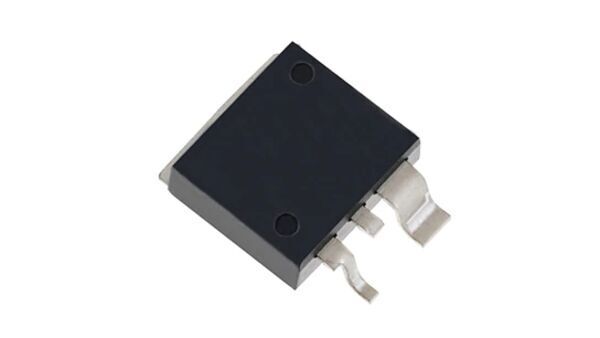
Toshiba’s New 100V N-channel Power MOSFET Helps Reduce Power Consumption of Automotive Equipment
"Toshiba Electronic Devices & Storage Corporation (“Toshiba”) has released “XK1R9F10QB,” a 100V N-channel power MOSFET suitable for automotive 48V equipment applications such as load switches, switching power supplies and driving of motors. Shipments start today. The new product is the first in Toshiba’s new U-MOS X-H Series of MOSFET with a trench structure, and is fabricated with the company’s latest generation process. Mounted on a low-resistance TO-220SM(W) package, it delivers industry-leading low On-resistance, with a maximum On-resistance of 1.92mΩ, an approximate 20% reduction against the current “TK160F10N1L.” This advance helps to reduce equipment power consumption. It also delivers reduced switching noise, due to optimization of capacitance characteristics, which helps to reduce EMI[3] of equipment. In addition, the threshold voltage width is tightened to 1V to enhance switching synchronization when used in parallel." [...]
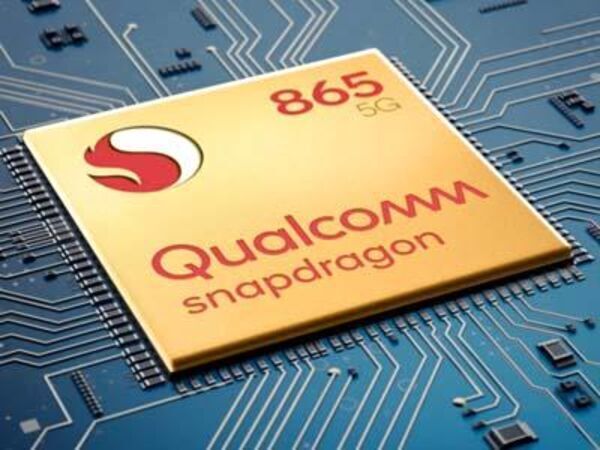
Flagship Qualcomm Snapdragon 865 5G Mobile Platform Powers First Wave of 2020 5G Smartphones
"Qualcomm Technologies, Inc. announced that global original equipment manufacturers (OEMs) and brands ASUS, Black Shark, Fujitsu Connected Technologies Limited, iQOO, Lenovo, Nubia, OPPO, realme, Redmi, Samsung Electronics Co., Ltd, Sharp Corporation, Sony, vivo, Xiaomi and ZTE have selected the Qualcomm® Snapdragon™ 865 5G Mobile Platform for their 5G device launches this year. The Snapdragon 865 Mobile Platform is the world’s most advanced mobile platform, designed to deliver the unmatched connectivity and performance required for the next wave of flagship devices, and features the Company’s second-generation 5G Modem-RF System, the Qualcomm® Snapdragon™ X55, while redefining Wi-Fi 6 and Bluetooth audio with the Qualcomm® FastConnect™ 6800 mobile connectivity subsystem. The cutting-edge Snapdragon 865 enables premium devices with breakthrough features—from Gigapixel-speed photography and Qualcomm® Snapdragon Elite Gaming with desktop-level features to intelligent and intuitive experiences due to the 5th generation Qualcomm® AI Engine. “As the world’s leading wireless technology innovator, we are committed to driving and scaling 5G to the consumer. This year, the Snapdragon 865 will help make 5G accessible to billions of smartphone users around the world, further enabling immersive mobile experiences like high-speed gaming, intelligent multi-camera capture and all-day battery life,” said Alex Katouzian, senior vice president and general manager, mobile, Qualcomm Technologies, Inc. After introducing the Snapdragon 865 Mobile Platform in December 2019, more than 70 designs have been announced or are in development based on the platform. Additionally, more than 1,750 designs have been announced or are in development based on our Snapdragon 8-series mobile platforms." [...]
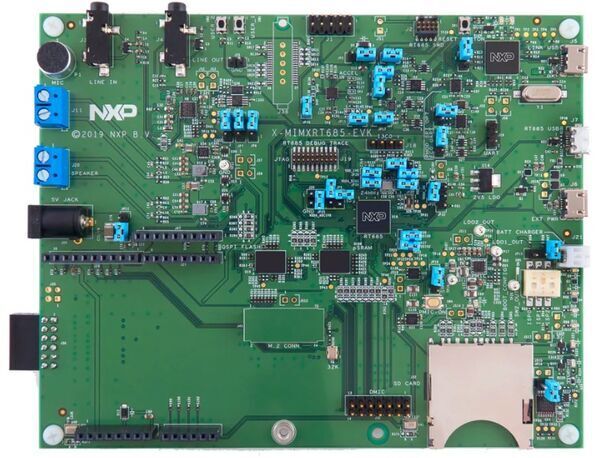
NXP Announces Availability of i.MX RT600 Crossover Family of Microcontrollers
"NXP Semiconductors today announced market availability of the i.MX RT600 crossover microcontroller (MCU) family, an ideal solution for ultra-low power, secure edge applications including audio, voice and machine learning. The i.MX RT600 crossover MCU provides optimal balance in power, performance, and memory. Features include: Arm® Cortex®-M33 running up to 300 MHz Optional Cadence® Tensilica® HiFi 4 audio/voice digital signal processor (DSP) running up to 600 MHz with Quad 32x32 MAC Up to 4.5 MB on-chip SRAM with zero wait-state access for critical code and data 28nm FD-SOI process optimized for both active and leakage power NXP’s advanced embedded security technology - EdgeLock™ 400A Optimized machine learning support using Glow neural network compiler* About the i.MX RT Series of Crossover MCUs The i.MX RT series of crossover MCUs are designed to bridge the gap between high-performance and integration while minimizing costs to meet today's need for high performance embedded processing at the edge. The series delivers advanced microcontrollers (MCUs) with the functionality of applications processors, at low costs, enabling advanced computation and machine learning capabilities in millions of connected edge devices. Product Availability and Support The i.MX RT600 MCU family is available with a suggested resale price starting at $4.50 (USD) for 10,000-unit quantities. NXP will accompany the silicon release with an i.MX RT600 evaluation kit at a suggested resale price of $129 (USD)." [...]

Maxim Integrated’s ChipDNA PUF Key Protection Technology Enables Market’s Most Secure IoT Microcontroller
"MAX32520 provides the most secure boot for root-of-trust to protect connected healthcare, industrial and computing systems Maxim Integrated Products, Inc. (NASDAQ: MXIM) introduces the MAX32520 ChipDNA™ secure Arm® Cortex®-M4 microcontroller, the first secure microcontroller with built-in physically unclonable function (PUF) technology for financial- and government-grade security. Maxim Integrated’s PUF technology allows for multiple layers of protection to provide the most advanced key-protection technology in a cost-effective format for use in IoT, healthcare, industrial and computing systems. As IoT applications continue to proliferate, large numbers of devices are being deployed in uncontrolled and hostile areas that make them more vulnerable to physical attacks. These are more sophisticated than software threats like poor crypto implementations or default password attacks. Designers want enhanced system defenses for their mission-critical applications where exposing secret encryption keys can bring down networks, ruin reputations, end companies and even negatively affect people’s lives. The MAX32520 with ChipDNA offers multiple layers of protection through its PUF technology, the industry’s most advanced key-protection technology for safeguarding secrets used in cryptographic operations." [...]
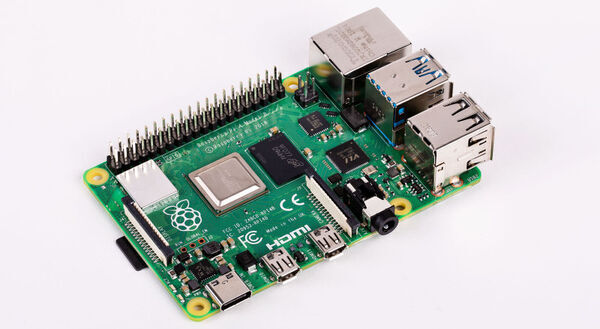
Get in the C: Raspberry Pi 4 can handle a wider range of USB adapters thanks to revised design's silent arrival
"There is good news for prospective buyers of the diminutive Raspberry Pi 4 as the USB-C issue that stopped the device working with some power supplies has been fixed. The issue arose with the change to a USB Type-C connector for powering the device. An error in detection circuitry on the Pi side caused some power adapters to mistake the computer for an audio device, and therefore not shove the expected power down the line. The Raspberry Pi Foundation's own USB power supply (yours for £8) was fine, other cables (marked with an "e") were less so. Pi fans have been speculating over the last few months that the fix had landed after purchasers reported spotting a new design in the wild. Back when the snafu was discovered, Pi supremo Eben Upton told The Register that a solution for the issue would "probably get rolled up into a design-for-manufacture spin of the PCB at some point"." [...]
Ciência e Tecnologia
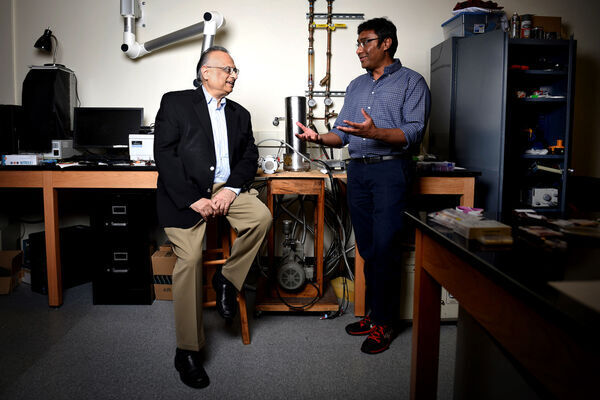
Physicists May Have Accidentally Discovered A New State Of Matter. The Possibilities Are Endless
"Humans have been studying electric charge for thousands of years, and the results have shaped modern civilization. Our daily lives depend on electric lighting, smartphones, cars, and computers, in ways that the first individuals to take note of a static shock or a bolt of lightning could never have imagined. Now, physicists at Northeastern have discovered a new way to manipulate electric charge. And the changes to the future of our technology could be monumental. “When such phenomena are discovered, imagination is the limit,” says Swastik Kar, an associate professor of physics. “It could change the way we can detect and communicate signals." [...]
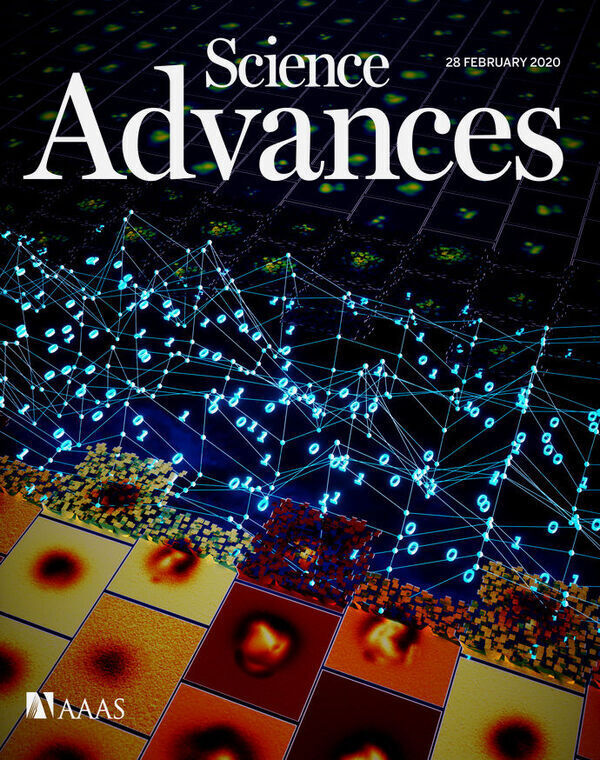
Researchers develop new methods for studying materials at the smallest possible scale
"Combining machine learning and atomic force microscopy allows researchers to see the chemical structures of 3D molecules Scientists around the world are interested in developing new materials to help people live more sustainable and healthy lives, but the quest to produce these materials requires detailed knowledge of the mysterious structures of the molecules they are made from. Designers want to replace wasteful plastic with sustainable plant derived compounds, but this can be a challenge without knowledge of plant compound’s molecular structure. A new technique developed at Aalto University should allow researchers to get this essential information. To achieve this, the researchers combined a common materials analysis technique with artificial intelligence. Atomic Force Microscopy (AFM) uses an incredibly fine needle to measure the size and shape of nanometer sized objects, and can already be used to measure the structure of flat, pancake-like planar molecules. By training an artificial intelligence algorithm on lots of AFM data, scientists can now identify more complex molecules with exciting real-world applications." [...]
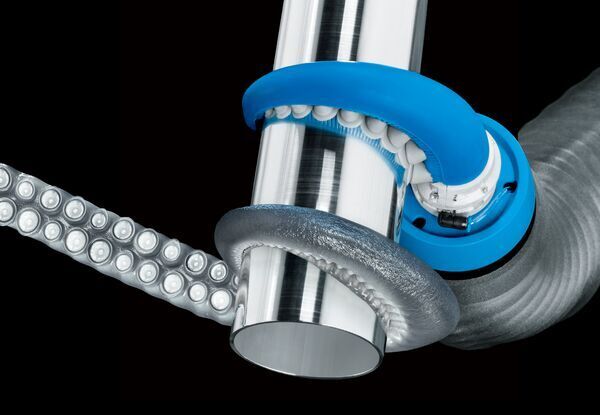
The Tentacle Bot
"Octopus-inspired robot can grip, move, and manipulate a wide range of objects Two-thirds of an octopus’s neurons are in its arms, meaning each arm literally has a mind of its own. Octopus arms can untie knots, open childproof bottles, and wrap around prey of any shape or size. The hundreds of suckers that cover their arms can form strong seals even on rough surfaces underwater. Imagine if a robot could do all that. Researchers at the Harvard John A. Paulson School of Engineering and Applied Sciences (SEAS) and Beihang University have developed an octopus-inspired soft robotic arm that can grip, move, and manipulate a wide range of objects. Its flexible, tapered design, complete with suction cups, gives the gripper a firm grasp on objects of all shapes, sizes and textures -- from eggs to iPhones to large exercise balls." [...]

Polymers get caught up in love-hate chemistry of oil and water
"Researchers at Oak Ridge National Laboratory and the University of Tennessee achieved a rare look at the inner workings of polymer self-assembly at an oil-water interface to advance materials for neuromorphic computing and bio-inspired technologies. Results published in the Journal of the American Chemical Society provide new insights on the way molecules pack and order themselves into “tunable” interfaces, monolayer thick surfaces with structures that can be modified for specific functionalities. “Understanding the design rules of the chemistry happening at the liquid-liquid interface ultimately informs how we can make new materials with custom properties,” said Benjamin Doughty of ORNL’s Chemical Sciences Division. The study expands interest in using soft materials to mimic lipid bilayers — selective membranes with important biological functions, such as processing signals across the brain’s neural network and transporting ions, proteins, and other molecules across cells. Co-authors previously designed biomimetic membranes using lipid-coated water droplets in oil and demonstrated their potential as sensory components for neuromorphic, or brain-like, computers with natural information processing, learning and memory. “Because lipids are inherently fragile and decay, we are interested in developing polymer-based counterparts that offer stability and can also give us a range of natural functionalities,” said Pat Collier of ORNL’s Center for Nanophase Materials Sciences, a DOE Office of Science User Facility." [...]
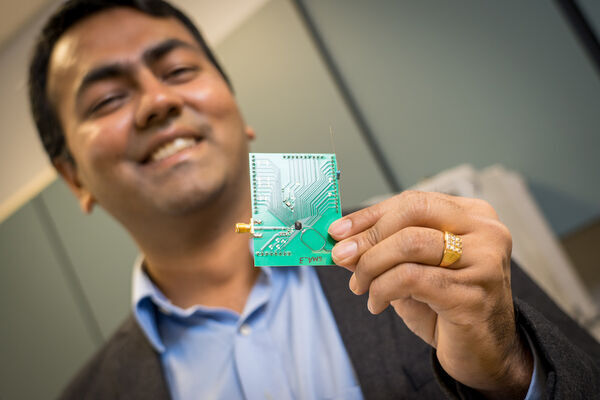
New Chip Brings Ultra-Low Power Wi-Fi Connectivity to IoT Devices
"More portable, fully wireless smart home setups. Lower power wearables. Batteryless smart devices. These could all be made possible thanks to a new ultra-low power Wi-Fi radio developed by electrical engineers at the University of California San Diego. The device, which is housed in a chip smaller than a grain of rice, enables Internet of Things (IoT) devices to communicate with existing Wi-Fi networks using 5,000 times less power than today’s Wi-Fi radios. It consumes just 28 microwatts of power." [...]
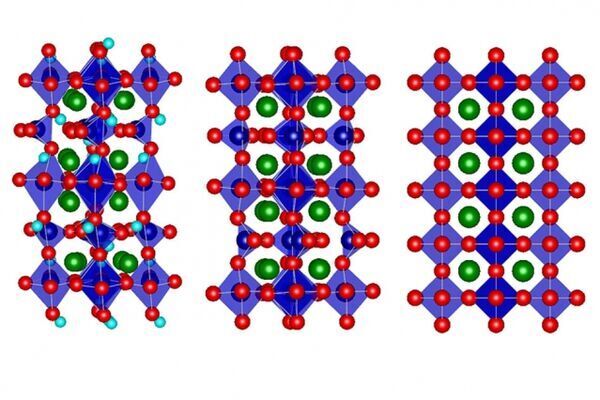
A material’s insulating properties can be tuned at will
"Most materials have a fixed ability to conduct heat, but applying voltage to this thin film changes its thermal properties drastically. Materials whose electronic and magnetic properties can be significantly changed by applying electrical inputs form the backbone of all of modern electronics. But achieving the same kind of tunable control over the thermal conductivity of any material has been an elusive quest. Now, a team of researchers at MIT have made a major leap forward. They have designed a long-sought device, which they refer to as an “electrical heat valve,” that can vary the thermal conductivity on demand. They demonstrated that the material’s ability to conduct heat can be “tuned” by a factor of 10 at room temperature." [...]
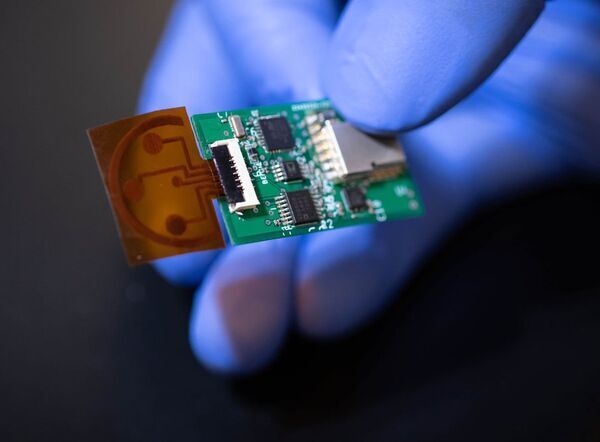
Sweat Sensor Detects Stress Levels; May Find Use in Space Exploration
"If someone asked you right now how stressed you are, what would you say? A little? A lot? You do not know? Those are all valid responses, but they are not especially useful to researchers and medical professionals because they are subjective and not easily quantified. Nonetheless, in lieu of a better method of measuring stress, the common method for years has consisted of a stress questionnaire." [...]

Movement of a liquid droplet generates over 5 volts of electricity
"Scientists have developed an energy harvesting device that generates over 5 volts of electricity from a liquid droplet. This device, made of flexible thin films, generates electricity when drops of liquid slide down along its surface. This technology is expected to be applied to IoT devices, such as self-powered sensors to monitor the quality of industrial wastewater. Energy harvesting, a technology to transform small quantities of naturally occurring energy (e.g. light, heat and vibration) into electricity, is gaining attention as a method to power the Internet of Things (IoT) devices. This technology helps reduce environmental impacts and has a potential to power electronic devices in a stable and long-term manner, unlike batteries that need recharging or replacing." [...]

New Green Technology from UMass Amherst Generates Electricity ‘Out of Thin Air’
"Renewable device could help mitigate climate change, power medical devices Scientists at the University of Massachusetts Amherst have developed a device that uses a natural protein to create electricity from moisture in the air, a new technology they say could have significant implications for the future of renewable energy, climate change and in the future of medicine. As reported today in Nature, the laboratories of electrical engineer Jun Yao and microbiologist Derek Lovley at UMass Amherst have created a device they call an “Air-gen.” or air-powered generator, with electrically conductive protein nanowires produced by the microbe Geobacter. The Air-gen connects electrodes to the protein nanowires in such a way that electrical current is generated from the water vapor naturally present in the atmosphere. “We are literally making electricity out of thin air,” says Yao. “The Air-gen generates clean energy 24/7.” Lovely, who has advanced sustainable biology-based electronic materials over three decades, adds, “It’s the most amazing and exciting application of protein nanowires yet.” The new technology developed in Yao’s lab is non-polluting, renewable and low-cost. It can generate power even in areas with extremely low humidity such as the Sahara Desert." [...]
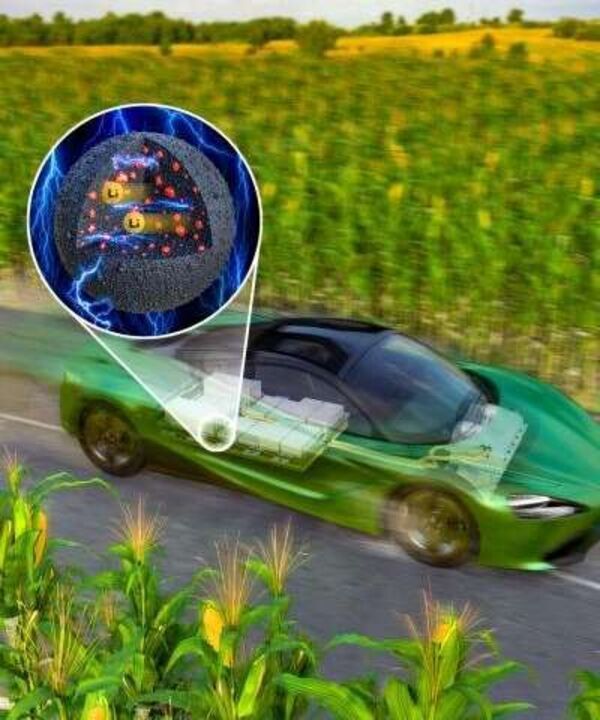
Researchers develop high-capacity EV battery materials that double driving range
"Dr. Hun-Gi Jung and his research team at the Center for Energy Storage Research of the Korea Institute of Science and Technology (KIST, President Lee Byung Gwon) have announced the development of silicon anode materials that can increase battery capacity four-fold in comparison to graphite anode materials and enable rapid charging to more than 80% capacity in only five minutes. When applied to batteries for electric vehicles, the new materials are expected to more than double their driving range. The batteries currently installed in mass-produced electric vehicles use graphite anode materials, but their low capacity contributes to electric vehicles' having a shorter driving range than vehicles with internal combustion engines. Consequently, silicon, with an energy storage capacity 10-times greater than graphite, has drawn attention as a next-generation anode material for the development of long-range electric vehicles. However, silicon materials have not yet been commercialized because their volume expands rapidly and storage capacity decreases significantly during charge and discharge cycles, which limits commercialization. A number of methods have been suggested for enhancing the stability of silicon as an anode material, but the cost and complexity of these methods have prevented silicon from replacing graphite." [...]
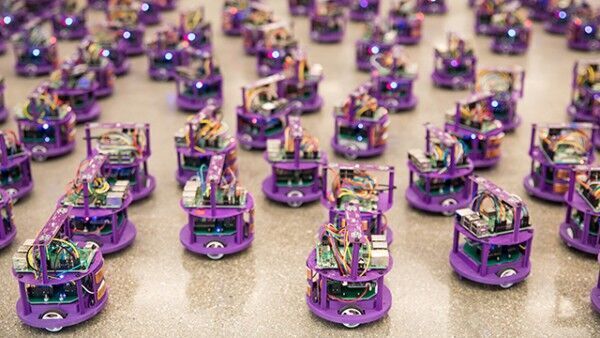
Swarming robots avoid collisions, traffic jams
"New algorithm could help control driverless cars, automated warehouses For self-driving vehicles to become an everyday reality, they need to safely and flawlessly navigate one another without crashing or causing unnecessary traffic jams. To help make this possible, Northwestern University researchers have developed the first decentralized algorithm with a collision-free, deadlock-free guarantee. The researchers tested the algorithm in a simulation of 1,024 robots and on a swarm of 100 real robots in the laboratory. The robots reliably, safely and efficiently converged to form a pre-determined shape in less than a minute. “If you have many autonomous vehicles on the road, you don’t want them to collide with one another or get stuck in a deadlock,” said Northwestern’s Michael Rubenstein, who led the study. “By understanding how to control our swarm robots to form shapes, we can understand how to control fleets of autonomous vehicles as they interact with each other.” The paper will be published later this month in the journal IEEE Transactions on Robotics." [...]

Using light to put a twist on electrons
"Method with polarized light can create and measure nonsymmetrical states in a layered material. Some molecules, including most of the ones in living organisms, have shapes that can exist in two different mirror-image versions. The right- and left-handed versions can sometimes have different properties, such that only one of them carries out the molecule’s functions. Now, a team of physicists has found that a similarly asymmetrical pattern can be induced and measured at will in certain exotic materials, using a special kind of light beam to stimulate the material. In this case, the phenomenon of “handedness,” known as chirality, occurs not in the structure of the molecules themselves, but in a kind of patterning in the density of electrons within the material. The researchers found that this asymmetric patterning can be induced by shining a circularly polarized mid-infrared light at an unusual material, a form of transition-metal dichalcogenide semimetal called TiSe2, or titanium diselenide." [...]
Documentação
A documentação é parte essencial do processo de aprendizagem e a Internet além de artigos interessantes de explorar também tem alguma documentação em formato PDF interessante de ler. Todos os links aqui apresentados são para conteúdo disponibilizado livremente pelo editor do livro.
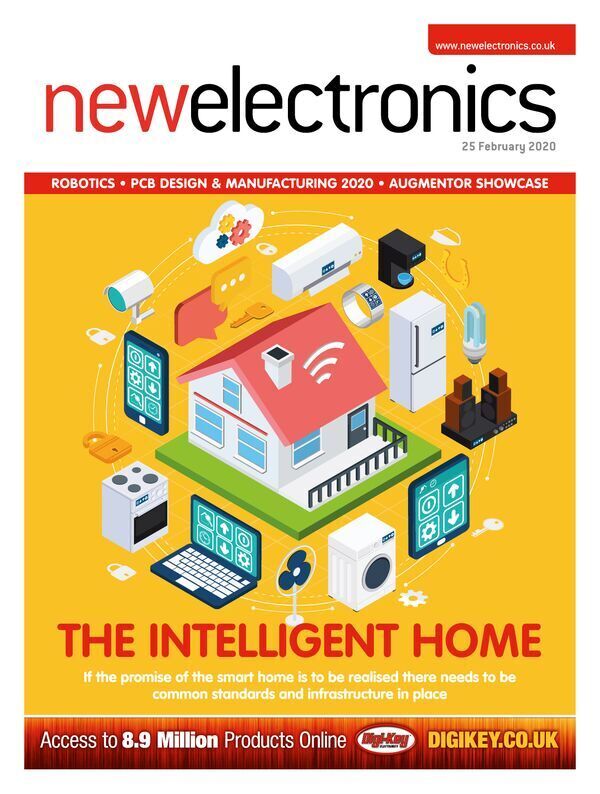
newelectronics 25 Fevereiro 2020
"New Electronics is a fortnightly magazine focusing on technological innovation, news and the latest developments in the electronics sector. Downloadable as a digital page turner or pdf file, or offered as a hard copy, the New Electronics magazine is available in a format to suit you. " [...]
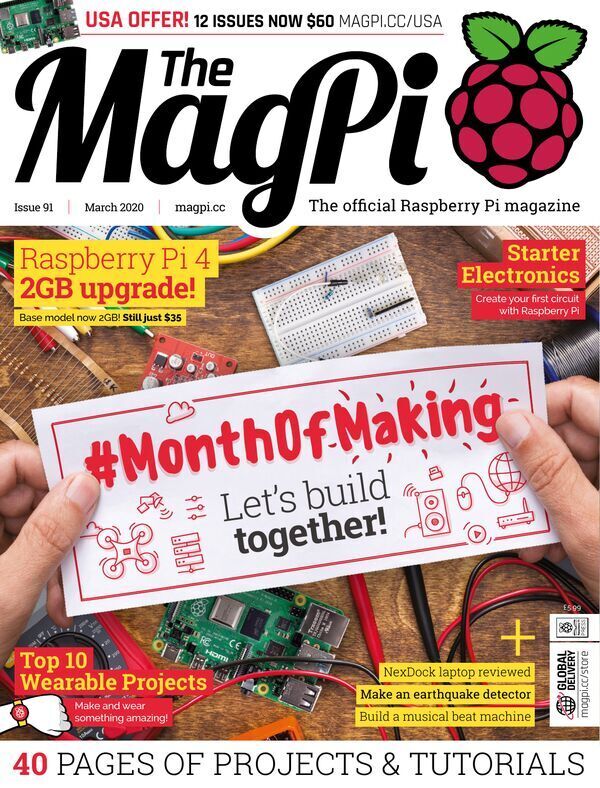
The MagPI 91
"Get involved with #MonthOfMaking in The MagPi magazine issue 91. Plus! Eben Upton talks to us about the new entry-level Raspberry Pi 4 with 2GB RAM. Inside The MagPi magazine issue #91 #MonthOfMaking. Get involved with the community and commit to making something this month. We will help each other to become makers." [...]

Code the Classics – Volume 1
"This stunning 224-page hardback book not only tells the stories of some of the seminal video games of the 1970s and 1980s, but shows you how to create your own games inspired by them using Python and Pygame Zero, following examples programmed by Raspberry Pi founder Eben Upton. In the first of two volumes, we remake five classic video games – ranging from Pong to Sensible Soccer, each represents a different genre. We interview the games’ original creators and learn from their example, as well as utilise the art and audio engineering skills of two of the 1980s’ most prolific games developers for our recreated versions of the games. - Get game design tips and tricks from the masters - Explore the code listings and find out how they work - Download and play game examples by Eben Upton - Learn how to code your own games with Pygame Zero - Read interviews with expert graphics and audio creators" [...]
Projetos Maker
Diversos Projetos interessantes.
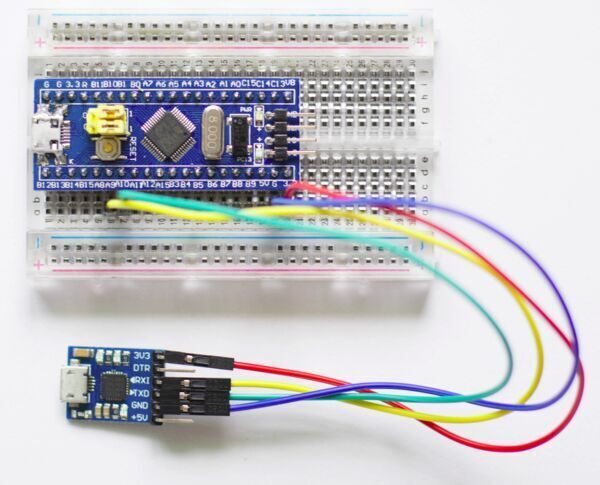
Nuttx on the STM32F103C8T6
"Wouldn’t it be C O O L to have a Linux prompt on the STM32F103C8T6. Not likely, however, Nuttx on the STM32F103C8T6 is about as close as you will get. Nuttx is a RTOS which runs on a wide range of microcontrollers including the STM32F103C8T6. To compile Nuttx for the STM32F103C8T6, a development environment needs set up with the right tools. My development OS of choice is a Linux distribution called Fedora (Fedora 29 is the current version at the time of this post). " [...]
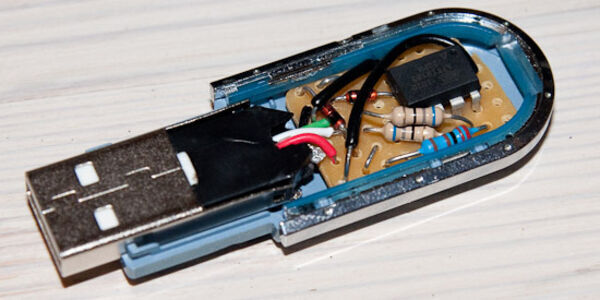
DIY USB password generator
"Having done half a dozen V-USB tutorials I decided it’s time to whip up something cool. As USB keyboards were an area untouched, I decided to make a small USB HID keyboard device that types a password stored in EEPROM every time it’s attached. A new password can be generated just by tabbing CAPS LOCK a few times (4 times to start password regeneration and one tab for each password character generated, 10 is the default password length). Below you can see the device in action: The place I work at requires me to change my password every few months so this would be one way to skip remembering a new password altogether (as long as I remember to write it down before regenerating a new one so password can be changed :). " [...]
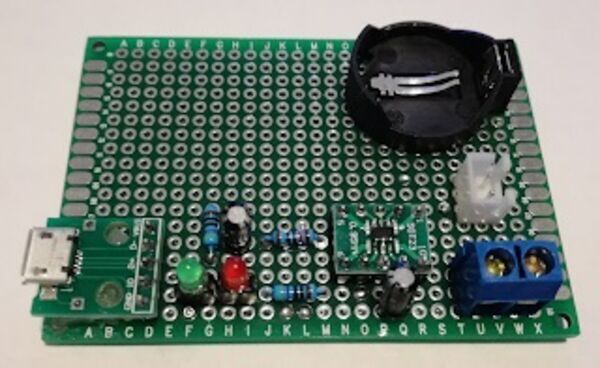
Prototyping of an MCP73831 based battery charger
"One of my ongoing projects is a very low-power electronics device that supposedly runs on a single-cell Li-Ion or Li-Polymer battery for a very long time, hopefully many-many months. In my idea, the battery actually could be a rechargeable one, e.g. LIR2032 or LIR2450 button cell, and I might also be able to recharge them during these months from a small solar panel, so ideally it runs “forever” with a single battery. I looked for charger circuits and found out there are many incredibly cheap single-chip solutions available. For some reason I do not remember any more, I picked the MCP73831 chip, which is a very small, single-cell Li-Ion, Li-Polymer battery charger IC. To be able to experiment with the chip, I just took the typical application schematics from the specification and created breadboard and perfboard diagrams." [...]
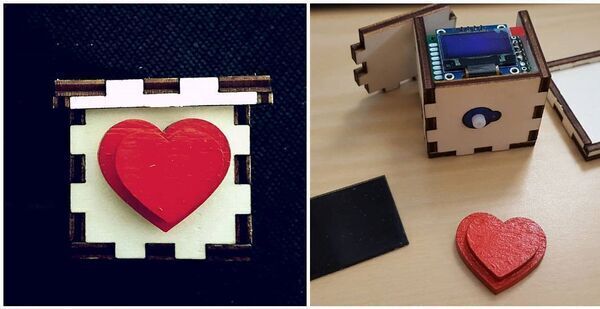
Lovebox
"DIY project to lasercut a lovebox inspired from https://en.lovebox.love/. It was a homemade Christmas present for my mom. So I can send her messages or pictures at any time to start the day motivated. When a new message is received, the heart moves in front of the box. It stops as soon as the message has been read (more specifically the built-in brightness sensor reacts when the box is opened). Have fun building your own!" [...]
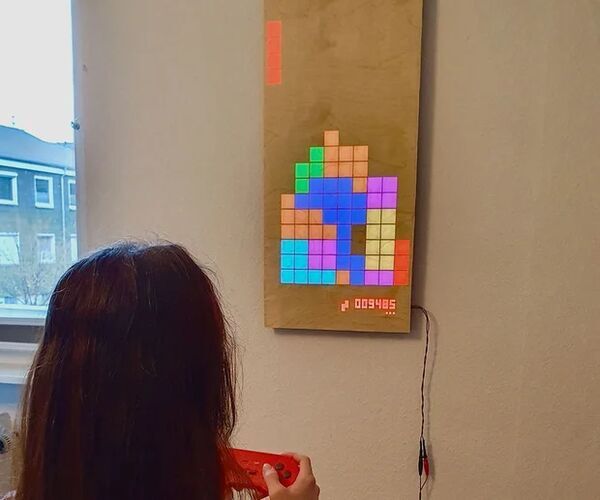
Wooden LED Gaming Display Powered by Raspberry Pi Zero
"This project realizes a 20x10 pixel WS2812 based LED display with a size of 78x35 cm which can be easily installed in the living room to play retro games. The first version of this matrix was built in 2016 and rebuilt by many other people. This experience was used to sum up all improvements to build a new version of the matrix and bring this now to instructables.com. Main new features are the update to a Raspberry Pi Zero instead using and Pi A plus an Arduino and replacing the previous large controller with a Bluetooth gamepad. Also the software was improved including the simulator, which allows you to develop the code on a computer even if you have no access to the matrix hardware. One special feature of this LED matrix is the special wood veneer, which is used to cover the LED and to hide them, when LEDs are disabled." [...]
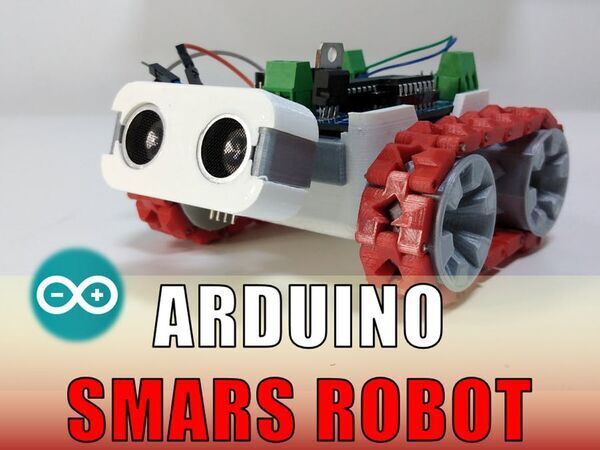
Arduino Robot 4WR
"During the making of this project, we tried to make sure that this tutorial will be the best guide for you in order to help you if you want to make your own robot, so we hope that this tutorial contain the needed documents. This project is so handy to make specially after getting the customized PCB that we’ve ordered from JLCPCB to improve the appearance of our electronic device and also there is enough documents and codes in this guide to allow you create your beautiful robot. We've made this project in just 4 days only, just one days to get all the needed parts and finish the hardware making and the assemble, then one day to prepare the code to suit our project and two days to create the Android app then we have started the testing and the adjustments. What you will learn from this tutorial: Making the right hardware selection for your project depending on its functionalities. Understand the robot mecanisme. Prepare the circuit diagram to connect all the choosen components." [...]
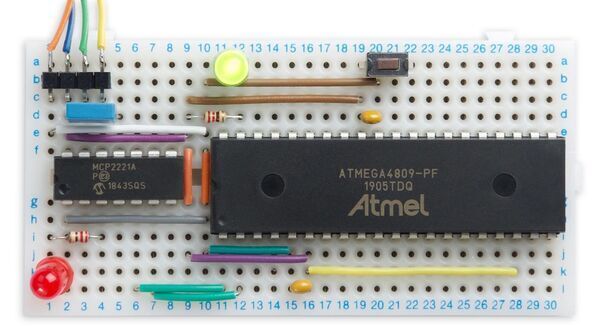
Minimal ATmega4809 on a Breadboard
"This article shows how you can build a minimal microcontroller on a breadboard based on the ATmega4809, the microprocessor used in the latest AVR-based Arduino boards It includes a USB-to-serial converter so you can connect it to your computer's USB port and program it from the Arduino IDE. Introduction Arduino's successors to their classic Arduino Uno board are the Arduino Nano Every [1] and the Arduino Uno WiFi Rev2 [2]. These are based on the ATmega4809 [3], one of Microchip's AVR processors from their new 0-series ATmega range. As well as having more program memory and RAM than the Arduino Uno's ATmega328P, the ATmega4809 has some interesting new features, including a 20MHz clock, an event system, and configurable custom logic. One of the attractions of the old ATmega328P was that it was available in a DIP package, making it ideal for prototyping. Microchip's latest range of AVR processors aren't available in DIP packages, with one exception: the ATmega4809 [4]." [...]
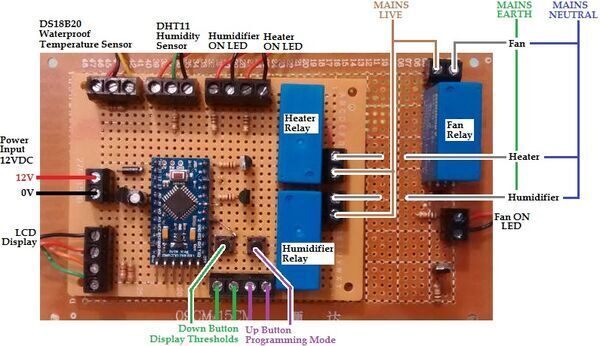
Poultry Egg Incubator with Humidity Sensor
"Pictured below is a controller we recently made for use in a poultry egg incubator, designed to keep eggs within a very narrow specific temperature and humidity range for a few weeks. This is achieved using a heater, a fan, and a humidifier. The eggs need to be turned at least three times per day every day except for the last few days before hatching. Previously we made a Controller for Poultry Incubator which had a motor which was turned on and off at different times of the day to turn the eggs. For this new incubator, the motor used is a very slow turning 12 VAC device makes 6 full rotations every 24 hours. That motor therefore did not need to be controlled with a timer – it is just left running at all times." [...]

Smart Room Lighting with ESP32
"Use some LED panels and strips along with an ESP32 and local webserver to control the lighting of a room from anywhere in the house. I recently purchased several new lights for an auxiliary workspace in my room, but there was a problem: it took far too long to turn the lights on and off. I also wanted to add some colored ambient lighting, and that also needed a way to be controlled, so I decided to create a web-based controller and WiFi-connected hardware to adjust the lights. Hardware Needed First and foremost, there had to be a webserver running the necessary services, such as MySQL, NodeJS, and Apache. I have published a guide on how to convert an old PC into a home server that can run all of these, which can be viewed here. If you don’t wish to use an entire PC, a simple Raspberry Pi can work, albeit quite a lot slower." [...]
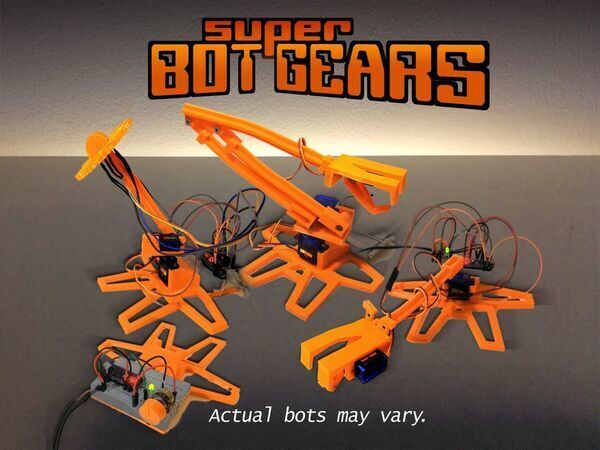
Super Bot Gears - a 3D-printed Arduino starter kit
"5in1 eucational Arduino-compatible set I made for my nieces This is an educational Arduino set I've prepared for my nieces to teach them about electronics. While I was at it - I decided to also make it Open Source and publish it on the internet for free! " [...]
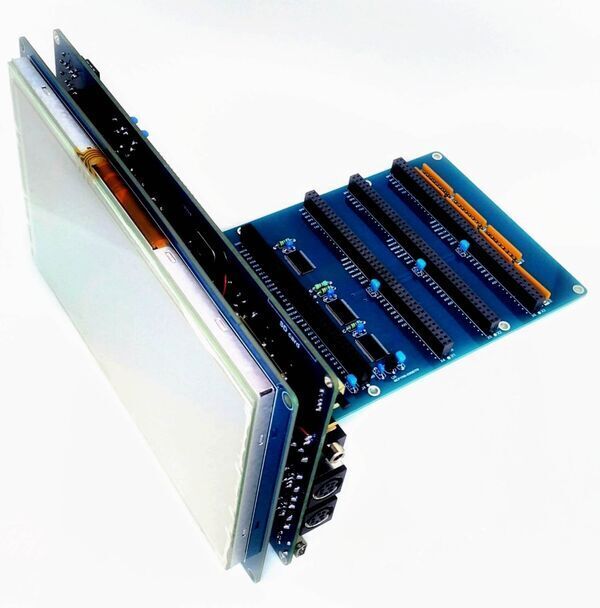
Z20X Open-Source Computing System
"Z20X is a simple expandable DIY computing system, built around the eZ80 microprocessor. I chose eZ80 due to its native simplicity and full backward code compatibility with the great and very popular Z80 and Z180. The design goal of Z20X is to offer a good DIY/LIY (Do-It-Yourself/Learn-It-Yourself) kit for system built with through-hole components, simple enough for assembly and learning in deep details, but without the constraints of using only old technology ICs. In order to maintain full exposure to technical details, the system also avoids using secondary MCUs or programmable logic, and sticks only with true hardware solutions. System Summary eZ80 running at 20 MHz (default on board) - 128 KB flash ROM (internal for eZ80) - 520 KB total RAM on board (512K external plus 8K internal) - 4 MB non-volatile storage (optional, can be upgraded by changing the IC) - Real-time clock - SSD1963-powered 7.0 inch TFT display with resolution 800 x 480 pixels and touch panel - SD card slot - YM2413 programmable sound generator with amplifier - PS/2 connectors for industry standard keyboard and mouse - Additionally installable processor modules - 72-pin expansion header with Z20X bus Optional expander board with Z20X bus sockets and bonus support for RC2014 bus eZ80 is a modernised and extended version of Z80. It maintains backward software compatibility with the latter, while adding several new assembler instructions as well as integrated memory and peripheral modules." [...]
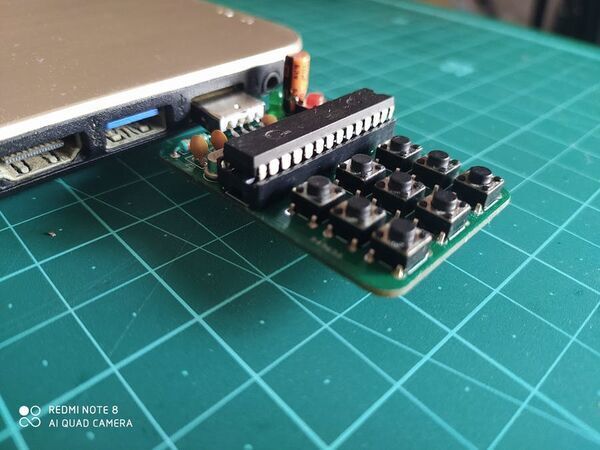
Ardu Keyboard
"Keyboards are one of the most important input device for a computer. A standard keyboard has more than 100 different keys for different purposes. Yet sometimes it feels like it'd be great if there're some programmable buttons to execute certain commands or a particular set of key combination. Keeping that in mind I have designed this Ardu-Keyboard, a programmable macro keyboard based on popular ATmega328P microcontroller. It has 9 push buttons connected in a 3 by 3 matrix format. Apart from that it has ATmega328P DIP IC in bare minimum configuration, a USB 2 point 0 male connector and CH340C USB to TTL converted IC, to talk to the microcontroller over USB." [...]
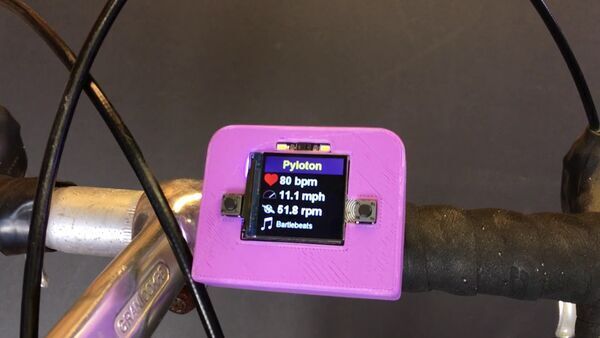
Pyloton: CircuitPython Cycling Computer
"Pyloton is a CircuitPython bike computer made with the CLUE board. Pyloton measures Bluetooth LE heart rate, speed, and cadence. It also provides Apple Music Service song info, combined on one small device with a sharp display and a 3D printed handlebar mount (or optional wrist mount). This project is the culmination of three previous Adafruit Learning System projects, plus some new abilities of our Bluefruit code to connect to multiple peripheral devices! Previously, we created these standalone projects: Now Playing: Bluetooth LE Apple Media Service Display BLE Heart Rate Zone Trainer Display BLE Cycling Speed & Cadence Sensor Display You may refer to those guides for additional details on the sensors, libraries, and code. Here, we'll show you how they can all be combined into one device." [...]
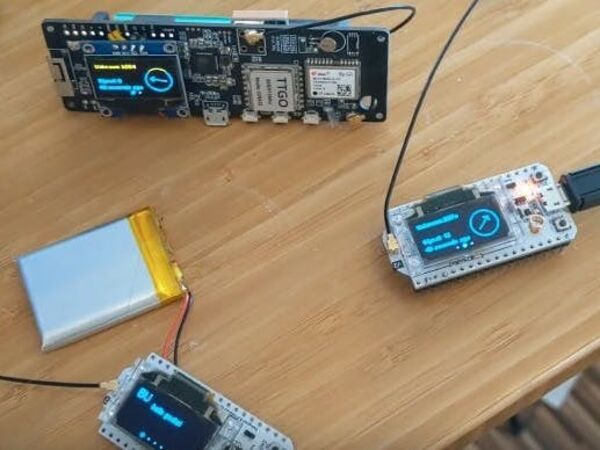
Meshtastic: A Hiking, Skiing, GPS Mesh Communicator
"Meshtastic is a project that lets you use inexpensive ($30-ish) GPS radios as an extensible, super long battery life mesh GPS communicator. Meshtastic is an open-source hiking, pilot, skiing, Signal app-extending GPS mesh communicator. Meshtastic is a project that lets you use inexpensive ($30 ish) GPS radios as an extensible, super long battery life mesh GPS communicator. These radios are great for hiking, skiing, paragliding - essentially any hobby where you don’t have reliable internet access. Each member of your private mesh can always see the location and distance of all other members and any text messages sent to your group chat. The radios automatically create a mesh to forward packets as needed, so everyone in the group can receive messages from even the furthest member." [...]
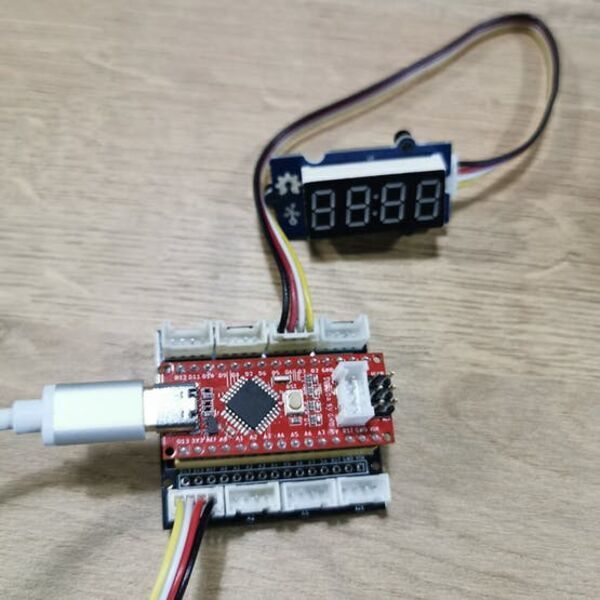
Grove Sensor Tester - Get Sensor Value in Seconds - Arduino
"A simple low cost tool to get analog/digital value of your Grove sensor in seconds, no PC and coding required, quick and straight. Grove Mate - A simply and low cost little tool for you to get the analog or digital value of your Grove sensor in seconds, no PC and coding required, quick and straight. Story Testing the sensor is the very first step when we start to build a new arduino interactive project using sensors. If you are a fans of open source hardware, you may have dozens of sensors in your drawer, and everytime you want to make use of them, you need to test them one by one to make sure whether it is a analog or digital sensor, or it is still in good condition, as well as how the analog value will change for different condition. The most common way of doing that is to write a program which to read the pin value and "Serial.print" to the serial monitor or display the figure on display equiment such as digital display tube or OLED. Well, it at least cost you a development board, a grove shield, and your valuable time to write that code, oh, and you also need to finish the work with a PC." [...]
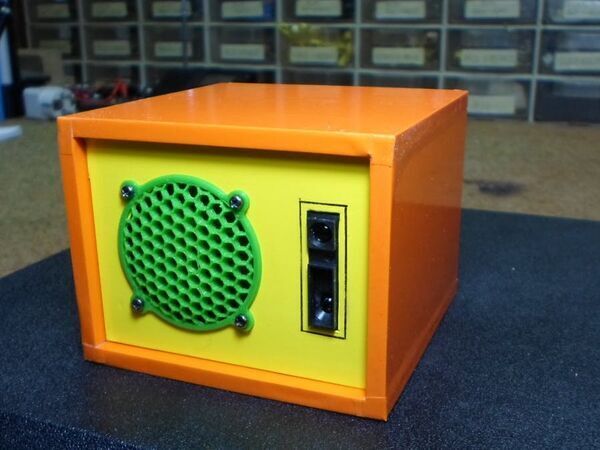
DIY Gesture Controlled Talking Clock
"Simplest Arduino "talking" clock suitable for people with weak or damaged eyesight. This is another of my collection of unusual clocks. The working principle is the following: When we move our hand in front of sensor, the clock tells the exact time at that moment with a synthesized "robotic" voice. The device is very simple and consists of an Arduino microcontroller, a DS3231 real-time clock module and small D-class power amplifier module with speaker. The code uses "Talkie" library (a software implementation of the Texas Instruments speech synthesis architecture from the late 1970s / early 1980s, as used on several popular applications). I got the code from : https://github.com/deladriere/Talking-Clock, and I modified it so that instead of a button, the watch is activated by hand gesture." [...]
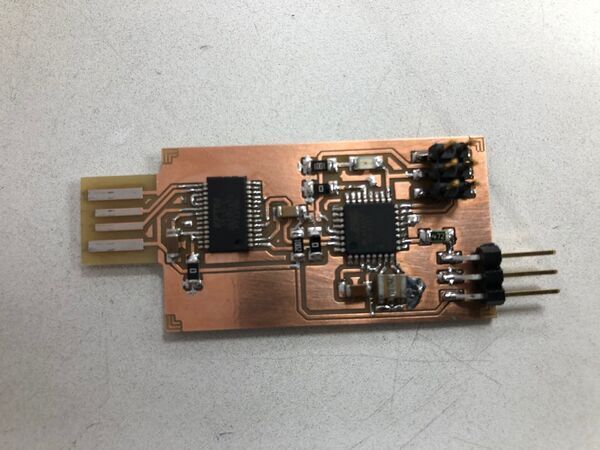
UPDI programmer compatible with Arduino IDE
"This board is a updi programmer that utilizes Arduino IDE to program AVR microcontroller. " [...]
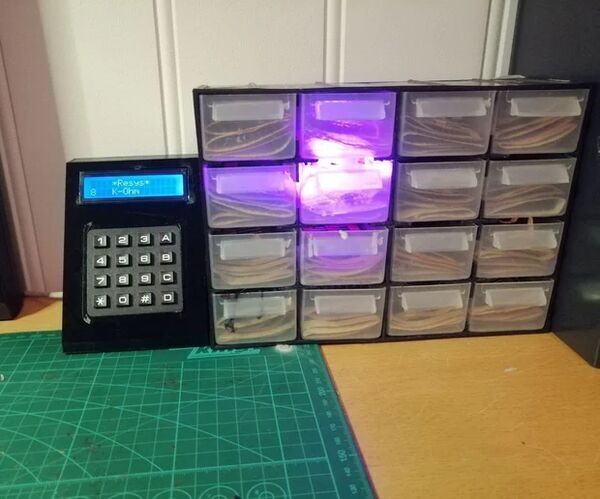
Resistor Storage Location System "Resys"
"This is a system that makes it easy to find your resistors. Search at desired value, and the right drawer lights up. This system can be extended to desired numbers of drawers. Supplies: Adressable LED's WS2812B Arduino Nano 4 x 4 Matrix Array 16 Keys Resistor's Usb charger, or other 5v powersupply PLA filament Connector Headers Prototyping PCB 10k potmeter" [...]
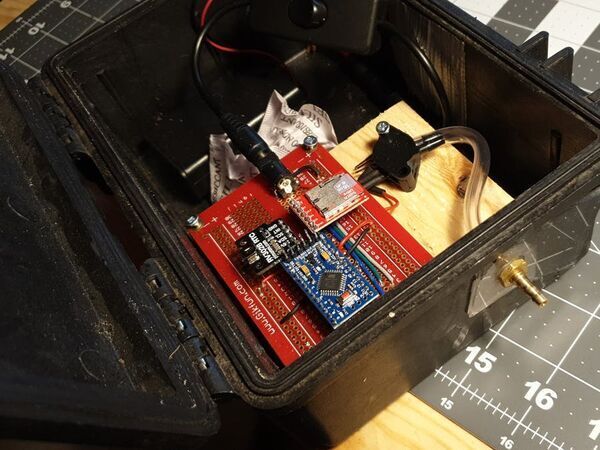
Arduino Car Counter
"A low-power Arduino car counter that works by logging each time a car drives over a rubber tube across the road. While talking about electronics at work, my colleague metnioned a car counter he’d bought for a large sum of money that never really worked. I had the idea that I could build one myself, from Arduino, and thought I’d give it a try. Internet searching found the following projects that I used as inspiration: Arudino people counting, using PIR (passive infra-red) Car counting using a rubber tube – anonymous project on makercave. This alsoincludes a really useful PDF from Tomorrowlab Car counting using a rubber tube – Tomorrowlab Kris Temmermen’s car counter on hackaday All of these sites were incredibly useful, both for ideas, inspiration and of course code help. The plan was to use a pressure sensor to record when there is a change in pressure inside a sealed rubber tube, such as when a car drives over it." [...]
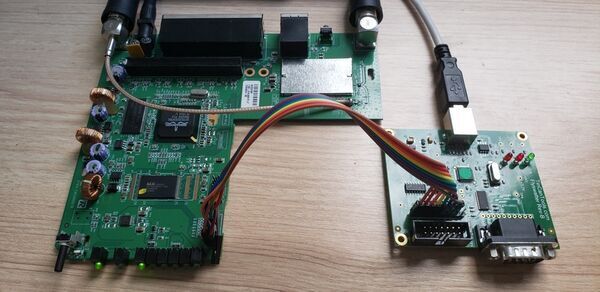
Extracting firmware from devices using JTAG
"JTAG is a physical hardware interface that makes it possible, among other things, to extract the firmware image from electronic devices. The firmware, a program that executes in a dedicated way and with a specific purpose in a microcontroller or microprocessor, is usually stored in a persistent memory device like a NAND/NOR flash or EEPROM. The extraction process involves reading and copying the firmware image stored in the device’s memory to a file on your computer. This process of extracting the firmware image is also called dumping or snarfing. But why extract the firmware from an electronic device? Why?" [...]
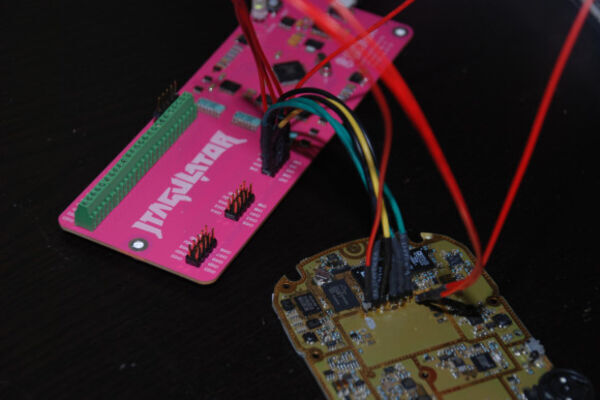
JTAGULATOR
"On-chip debug (OCD) interfaces can provide chip-level control of a target device and are a primary vector used by engineers, researchers, and hackers to extract program code or data, modify memory contents, or affect device operation on-the-fly. Depending on the complexity of the target device, manually locating available OCD connections can be a difficult and time consuming task, sometimes requiring physical destruction or modification of the device. JTAGulator is an open source hardware tool that assists in identifying OCD connections from test points, vias, or component pads on a target device. Assembled JTAGulators are available from Parallax, Inc. For questions and technical support, please contact [email protected]. Support is only provided for genuine JTAGulators, which are hot pink in color and contain verifiable serial numbers. This design is distributed under a Creative Commons Attribution-3.0 United States license." [...]

How to Make a CNC Plotter
"Build your mini CNC! Numerical control(also computer numerical control, and commonly called CNC) is the automated control of machining tools (drills, boring tools, lathes) and 3D printers by means of a computer. A CNC machine processes a piece of material (metal, plastic, wood, ceramic, or composite) to meet specifications by following a coded programmed instruction and without a manual operator. " [...]
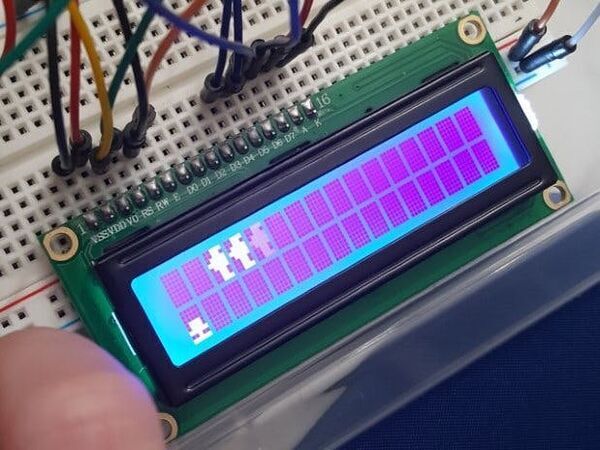
LCD Hill Run v2 Runner Game
"A simple LCD screen game where you jump over hills and duck under crows with buttons. " [...]
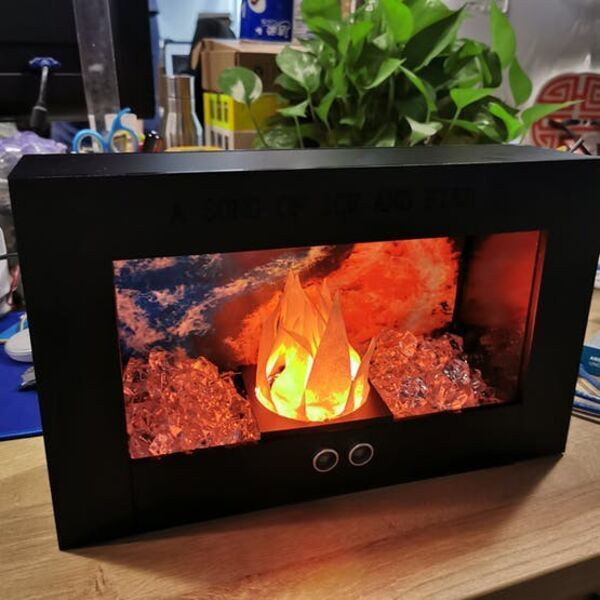
Mini Fireplace of A Song of Ice and Fire Theme
"A mini fireplace with burning flame surrounded by ice, to make a song of ice and fire in your home. For fans of Game of Thrones. " [...]
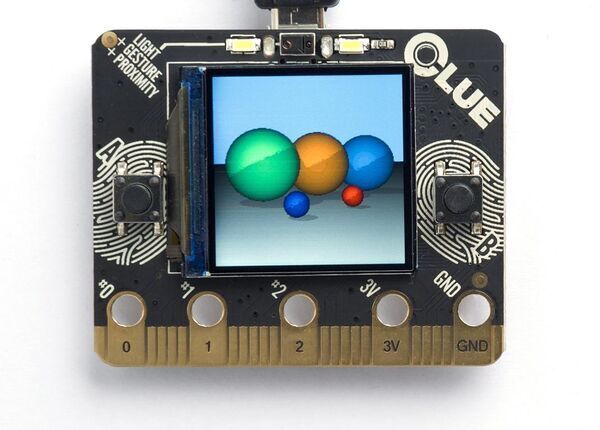
Ray tracing with uLisp
"This is a simple ray tracer written in uLisp, running on a colour TFT display. The scene contains five spheres and a plane. " [...]
That's all Folks!



